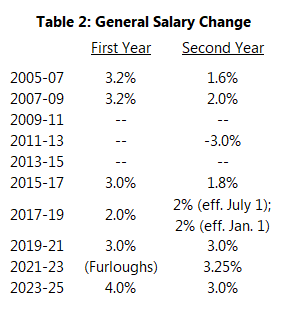10:24 am
October 17, 2022
The state negotiates collective bargaining agreements (CBAs) with general government employees, community college employees, certain law enforcement employees, and ferry employees. It also negotiates CBAs with certain non-state employees, and it negotiates with K–12 school employees over health care benefits. At a work session of the Joint Committee on Employment Relations last week, the Office of Financial Management (OFM) provided an overview of the 2023–25 CBAs.
In general, the agreements would increase state employee wages by 4% on July 1, 2023, and by 3% on July 1, 2024. They also include, for example, lump sum payments for certain employees and targeted increases for hard-to-fill jobs. (See OFM’s overview for more of the compensation items in the agreements. More details are also available in OFM memos.)
Table 1 shows the costs by type of agreement. Altogether, the CBAs would increase 2023–25 spending from the general fund–state (GFS) by $1.401 billion and from all funds by $2.239 billion. According to OFM, the four-year GFS cost is estimated to be $2.893 billion. Typically, the Legislature extends the salary changes agreed to in the CBAs to employees who are not represented by unions. The cost of doing so is not included in the table.

Still, the estimated costs are substantial. Indeed, the CBAs would put the estimated outlook for 2023–25 out of balance. The official outlook based on the 2022 supplemental to the 2021–23 budget estimated it would leave an unrestricted ending balance of $374 million in 2023–25. Since then, the September revenue forecast increased expected NGFO revenues compared to the February forecast (on which the current budget was based) by $1.747 billion over a three biennia period (2021–23, 2023–25, and 2025–27). If you take the official budget outlook and adjust it to reflect the September revenue forecast, add in the increased collections from the October collections report, and add in the 2023–25 GFS cost of the CBAs, the unrestricted ending balance in 2023–25 would be negative $161 million. (That assumes that the outlook’s estimate of the cost of continuing 2021–23 appropriations into 2023–25 is still accurate, and it doesn’t incorporate any spending requests agencies have made for the 2023–25 budget.)
The CBAs’ general wage increases (4% and 3%) are the largest increases state employees have seen (as shown in Table 2). Recall that the 2021–23 CBAs were negotiated in 2020, at a time when the state expected major revenue shortfalls. Consequently, they included employee furloughs. The 2022 budget, adopted after revenues recovered, added a 3.25% general increase.

In December, OFM will determine whether the agreements are financially feasible. If so, the Legislature must either approve or reject the CBAs (it cannot make any changes to them).

Tags: 2023-25
